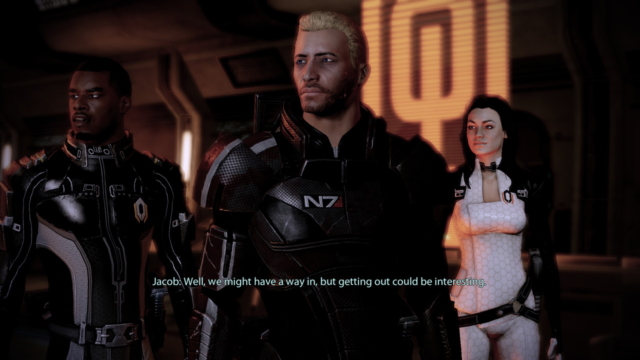
Mass Effect 2
Written by: Rik
Date posted: April 23, 2021
- Genre: RPG
- Developed by: Bioware
- Published by: Electronic Arts
- Year released: 2010
- Our score: 9
You’d think that the middle part of an ambitious trilogy, a space epic with hours of content, following on from a highly successful first instalment, would feel confident in awarding itself a portentous subtitle. But no: just plain old Mass Effect 2 will do – it’s the second game, the sequel to the first one. Even the supporting cover art is surprisingly lame in its depiction of a generic male version of protagonist Commander Shepard demonstrating some planetside machismo, flanked by hitherto unfamiliar sidekicks.
Perhaps the use of subtitles was reserved for the various DLC packs that were released to supplement the main game, or are part of it but were taken out and sold separately, depending on your point of view. And I’m sure the forthcoming Legendary Edition of the trilogy will make sure that everyone knows just how epic and important this three part battle between good and evil was and is.
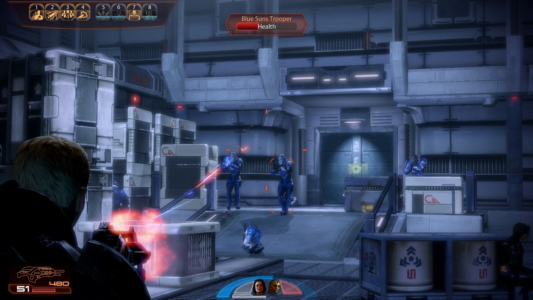
The most frequently encountered enemies come from one of three mercenary groups: Blue Suns, Eclipse and Blood Pack.
For now, though, this review means that your correspondent has finally got around to the original 2010 release that has been sitting in his Steam library for some considerable time. With a recent run through of the first game reasonably fresh in the memory, and some free time to spare for once, it seemed appropriate to push on through to this highly-acclaimed second chapter now while there was still some chance of retaining the details of pertinent plot points and choices made in the original, which also carry through across the trilogy.
Despite some unanticipated technical wrangling in other areas, the process of importing a save from the original Mass Effect was pretty straightforward and unproblematic, although the game does then reduce your epic 30-hour quest of galaxy saving to a rather bald list summarising the main story decisions: you took path B here, saved character X there and made choice A at the end. Import completed, you’re then free to revise your class or appearance, or indeed ignore everything you did last time and start afresh with certain ‘default’ story choices in place. (And this is what you’ll have to do if you haven’t played the first game or have somehow misplaced your save).
And so, it was a return to action for my peroxide blonde, crisis-of-masculinity man-Shep, although the transfer process had the effect of seemingly smoothing out his scars and taking a pleasingly home-made, over-the-bath dye job and turning it into more of a salon look. (His teeth remained pleasingly wonky and unAmerican, however, particularly when compared with the pristine gnashers of human colleagues).
Without spoiling anything too much, the progress made by our hero and his/her team in Mass Effect is pulled apart and reset in rather spectacular fashion at the start here, leaving Shep alone and on the outside as we start our adventure. Those disappointed by the old crew being disbanded should fear not, however, and bear in mind the deliberate links between the games. At the outset, though, you’re surrounded by new characters that you don’t trust and who don’t seem to trust you, on the margins of the galaxy, and a long way from the heroics of the first game.
As before, the opening exchanges act as a tutorial of sorts, and those familiar with the setup from the original will note a few changes. The action is altogether a bit slicker this time around: the cover mechanic is retained and improved, as Shep can now knee-slide towards crates as well as vaulting over them as needed. Meanwhile, the infinite ammo of the first game has been revised, with the rather unconvincing explanation that ammo clips have been introduced as an improvement to reduce overheating. In other words, you now have to keep an eye on the number of rounds remaining and pick up extra ammo as needed, in the traditional manner of most shooty-man type games.
Meanwhile, skills with weapons are automatically assigned, depending on your class, rather than trained and developed individually, and so my Soldier Shep, previously only a specialist in assault rifles, could now also use pistols, shotguns and sniper rifles with equal proficiency. Heavy weapons are another addition, and provide an extra dimension to battles, whether on the attack or under fire. The pause menu is retained, allowing you to manage powers and weapons and issue instructions to your team away from the immediate heat of the firefight. You can also now direct the two squad members supporting Shepard on each mission to move to a specific area by looking at it and hitting a shortcut key. Finally, the use of medi-gel is now linked to the Unity power, which is available from the start.
Immediate tutorial crisis over, the scene is set, and the overarching threat of the first game’s big bad has only temporarily been assuaged, with the Reapers now apparently working with a new set of alien ciphers, the Collectors. With human colonies under attack and the Citadel Council unwilling to intervene or investigate, it is left to Shepard to work with the human paramilitary group Cerberus to build a team capable of surviving a trip through the hazardous Omega 4 relay, from which no ship has ever returned, to take on and defeat the Collectors. And so, in RPG tradition, the world is open for you to explore and meet and recruit new characters, until you are ready to take the final leap into the unknown and confront what lies beyond.
The emphasis here really is on building a team and getting them ready for that final mission, and time spent recruiting new members, using and developing their expertise, and securing their loyalty, ultimately increases your chances of success. Although Shep starts by asking for his old team back, the leader of Cerberus, the Illusive Man (played against type by cuddly ex-US President Martin Sheen) states in reply that it simply isn’t possible, instead providing a list of leads to find alternative suitable squad mates, supplementing the two Cerberus lackeys already assigned, former Alliance soldier Jacob and company woman Miranda, who are with you from the start.
What this means in practice is that there’s a better balance this time between the plot based missions and side quests, which in the first game was the difference between enjoyable multi-layered storylines supplemented by varied action set-pieces and bouncing down to empty planets to visit generic warehouses filled with baddies with only a few pickups and a couple of lines of text as your reward. The line between the two is now blurred to a certain extent: initially recruiting team members is the mission, and although there are compulsory main story happenings at various points, they’re in the minority. In theory, you can skip some of the recruitment, but there are heavy hints that this would not be a good idea, even if you ignore the usual RPG maxim that consolidating your powers through optional quests is the usual way to go.
Upon arrival at a character’s specified location, there is a mission to complete in order to meet and/or convince the new squad mate to join you. Once successfully recruited, you then have the chance to visit them on board your ship and talk, and at some point they will reveal the details of some personal quest or other that they would really like to resolve, particularly if, as seems likely, their chances of surviving the events of the final mission are minimal.
Taking a cue from the optional missions for Garrus and Wrex in the first game, this builds further upon the idea by attaching these stories to a loyalty mechanic, which not only unlocks additional powers for each character upon completion (and for certain characters, develops opportunities for romance) but is also a factor in determining endgame outcomes. However much you may or may not speak to each character and choose cordial and friendly responses, loyalty only comes through the acceptance and successful completion of these particular missions.
A further dimension is added by the ability of some characters to suggest upgrades to the Normandy, some of which again improve your chances during the finale. These require resources other than money, which are acquired via a fairly repetitive planet-scanning process that takes the place of the largely-hated Mako bits from the first game. As upgrades go, it’s hard to say if it’s an improvement: I personally didn’t mind the Mako itself, but the supplementary assignment missions that involved botching about on a planet’s surface looking for wreckage before proceeding to a shootout against faceless mercenaries, I’m happy to do without.
Scanning planets is hardly exciting fare, but is altogether less time consuming than getting the Mako out, so as pointless busywork goes, if you really must have such things in place, it arguably does represent a form of streamlining. Scanning for minerals does also occasionally reveal unexpected anomalies, which are signs of a smaller-scale optional mission, and these are still rather more varied than those on offer in the previous game. Finally, one of the DLC packs (more on which here) does unlock another vehicle, the Firewalker, which is used on a series of associated (and not particularly interesting) missions. A hover-tank, it’s neither significantly more or less fun to control than the Mako, which causes you to question its inclusion in the first place.
Mineral resources are also required for other upgrades such as weapons and armour. While some upgrades can be found in the field or purchased from a merchant, others require research and an investment of raw materials. To be honest, I found it a little hard to follow which upgrades were found, bought or researched, and merely resolved to acquire as many credits and minerals as possible and research and buy everything as soon as it became available, unless it really didn’t look particularly useful. The process sort of implies that research can give you a head start in some areas and that all of the scanning and hoarding minerals will pay off somehow, but the availability of projects and upgrades is entwined with progress in missions, which means that it’s the game, rather than the player, that remains largely in control of what you get and when.
You do also have to spend money on probes required for scanning, and also, occasionally, fuel for your ship, which you have to steer between different systems in a particular cluster this time around. While this appears at first to be another potential complication to monitor and take into consideration, it doesn’t appear to have much significant impact on the game, which again sort of makes you wonder why they bothered. If I had my time again, I possibly would not have spent as much money on probes and as much time scanning planets as I did, with large mineral stockpiles remaining unused at the end of the game, prompting thoughts regarding the ethics of unregulated and unnecessary freelance mining across the galaxy, a topic that, unsurprisingly, is not a real consideration in the game.
Dealing with and managing your equipment and inventory was a sore point in the previous game, and it has been tidied up considerably, so there’s no choosing between various brands of gun and micro-managing ammo types and upgrades here, nor is there any need to sell or reduce items to omni-gel (which has seemingly gone the same way as the Mako) one at a time. Even though ammo is now a consideration, the clips are universal and found as you need them in levels rather than being something you need to manage too closely. Indeed the main management is now within the action itself, and in switching between the various weapons as ammo becomes depleted, or using the most appropriate weapon or power for the task in the heat of battle.
There certainly seems to have been a deliberate shift from the slightly clunky RPG aesthetic of the original to more of an action-based approach here. While that certainly represents progress in some respects, in that combat is all a lot smoother and easier to navigate, it sort of feels a bit less tactical and numbers based. And at the normal difficulty level, at least, it can also seem as if battles sometimes resolve themselves quite quickly without much thought, and with occasional idiotic blundering being rather too easily forgiven.
This goes beyond the combat sequences and into other areas of the game, and having finally become more accustomed to how the skill system worked in the first Mass Effect, in terms of allocating points and making proper use of each party member, the comparatively limited number of attributes for squad mates here, including Shepard, did seem a little jarring.
On the other hand, I guess it did feel pretty stupid previously when a character wasn’t trained in the use of a particular weapon and could barely do anything of use with it. The battles are better now too, with less of the action being focused on narrow corridors and enclosed areas, allowing you to be flanked by enemies (and do the same to them), and meaning you have to pay a bit more attention to the wider context of a shootout than before. Some of your cover is also now destructible too, with crates getting blown away if hit, forcing you to look elsewhere. Having said that, the boxy nature of the environments is still notable to some extent, and you do find yourself mentally preparing for combat when approaching a room with lots of crates laid out in suitable cover positions.
The mechanics of such things are of course only part of the picture, and in terms of story and setup, Mass Effect 2 certainly goes in an interesting direction, with Shepard on the margins, both figuratively and literally, despite his/her prior heroics. Although you can return to the Citadel, it is only one of three main city-like hubs, and arguably now the least interesting, with the scummy danger of Omega and the slick business environment of Illium more suitable settings for the semi-rogue Shep to meet new characters and pause his galaxy-saving quest to intercede in some local trivialities. In some ways, it’s a shame for the Citadel to have lost some of its previous majesty, explained away here as a by-product of the damage sustained in the Mass Effect finale, and for Shepard’s heroics to have largely been ignored by the Council, but it does allow a new story to be told.
The presentation has been suitably ramped up, with not only a wider variety of planetary settings for missions, but also a more cinematic approach to camera angles and dialogue scenes. The only slightly dated seeming moments are the occasional video sequences, which are notably grainier than the in-game graphics, but it’s a definite step up overall. There’s less of a conspicuous reliance on the ‘walking from side to side while thinking’ animation, and more fluid and natural movement during dialogue, while the dialogue wheel allows for slightly more normal conversations than the laboured information gathering of ME (although the nature of the game kind of demands that some awkward and stilted questioning must remain in place).
The previous game’s Charm and Intimidate skills come from directly from Paragon/Renegade behaviour in game, rather than allocation of skill points, and there are occasional opportunities to make Paragon and Renegade interruptions/interventions during dialogue scenes with a timely push of a button. As before, it doesn’t seem as if there are any great disadvantages in being a good boy or girl, with a high Paragon score able to ultimately get around any problems seemingly caused by not taking more direct or assertive action.
Arguably the major downside is being a big dork, and certainly my man-Shep didn’t seem particularly cool as he defused and/or pacified tense situations with mildly cheesy rhetoric. At times it seemed like the once mighty Spectre was being treated like a fairly major doofus out in the wider world, an impression he seemed in no hurry to overturn, asking for everything to be explained to him and never missing an opportunity to state the obvious. It perhaps didn’t help that my chosen look seemed to morph him from a grizzled war hero with a scar to a divorced ex-racing driver living out his early retirement in a tax haven. I also ended up choosing not to pursue any romantic options as it seemed unfathomable that my Shep could be anything other than a likeable if distinctly unsexy boss man. Plus should the Commander of a ship be sleeping with his crew anyway? I’d say not.
As the story does take a fairly sharp turn away from Mass Effect, those expecting direct follow-on from various prior choices might be disappointed. However, old friends and characters do turn up and behave according to how things played out in the previous game, and there are enough of those moments sprinkled throughout to realise how many moving parts it’s keeping track of. Entire major characters may or may not appear depending on what you did in Mass Effect, while a number of minor ones appear at various points for a brief chat about a relatively insignificant mission or exchange. When you consider that this all needs to feed in again to the third game, you understand the scale of ambition here.
That ambition is also evident in the number of new characters and stories introduced. With only three in an active squad, it’s certainly tempting to wonder why you need quite so many colleagues at your disposal, with only the instinct to amass resources and the repeated mentions of needing a strong team acting against the need to address the apparent urgency of the situation. Once you come to understand the complexity of, and number of different possible outcomes from, the final mission that lies beyond the Omega 4 relay, it becomes all the more impressive. While you can blunder in too early and still get to the end, that’s not without consequences; while on the other hand, even taking every precaution in advance won’t necessarily protect you against bad choices in the mission itself. Along the way, of course, you will have come to know, like, and become attached to your squad members, which makes any losses even more impactful.
The only real negative in terms of the finale is that the big baddies themselves aren’t particularly inspiring. While we find out a lot more about the characters and races we met last time around, even including the robotic Geth, who provided the bulk of the cannon fodder last time, the lack of a charismatic baddy like Saren is notable, and the Collectors aren’t desperately interesting as a foe. There is a boss Collector called Harbinger who turns up at various points and starts muttering vaguely camp threats at you during battle, but he seems distinctly non-threatening. And the final big boss reveal that comes at the end of the climactic mission struck me as a little bit silly. The most intriguing machinations are on the other side – ostensibly your side – with many looking after their own agendas, outside of this particular conflict.
Such concerns, although relatively minor, allied to a slight feeling of disappointment that some of the complexities of the previous game were sanded off along with the rough edges, perhaps prevent me from bestowing the highest possible accolades on Mass Effect 2. (And I do miss the synth music of the last one, supplanted here by more ‘epic’ sounding strings). But it’s a massive leap forward from the original in most respects, and a highly impressive accomplishment overall. Were it possible to imagine a time in which spending another 40 or so hours digging through the game and trying different options was feasible, it would certainly not be an unappealing prospect. As it is, though, a single journey through the story provides rich rewards for your investment of time, with the prospect of seeing how it all plays out in the final instalment still to come.

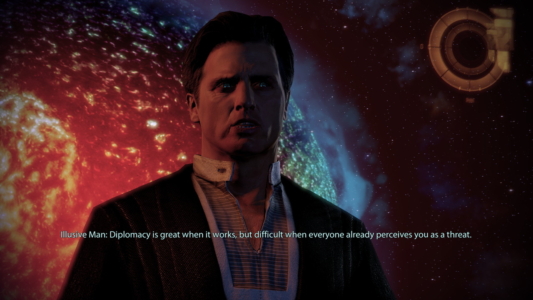
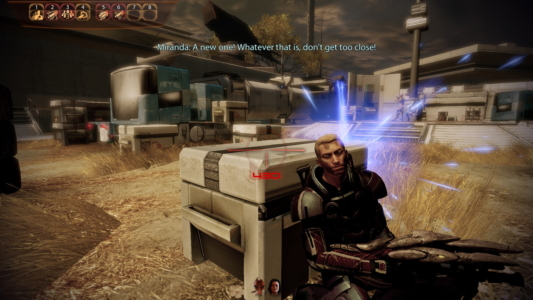
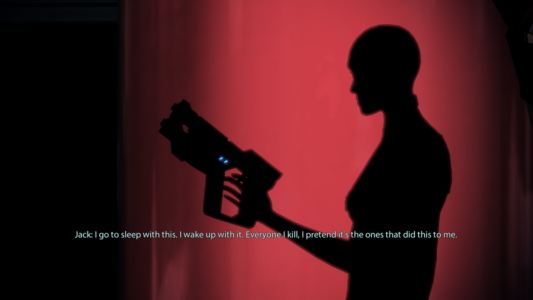
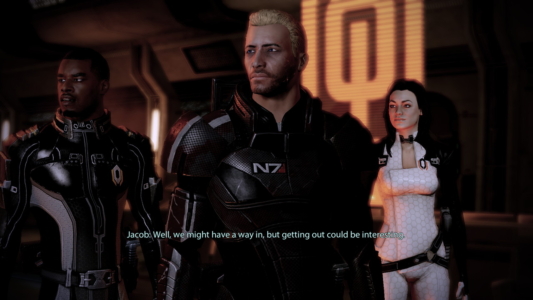
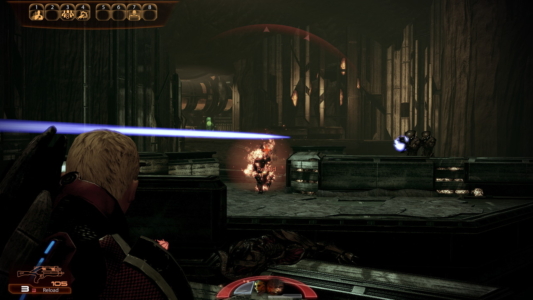
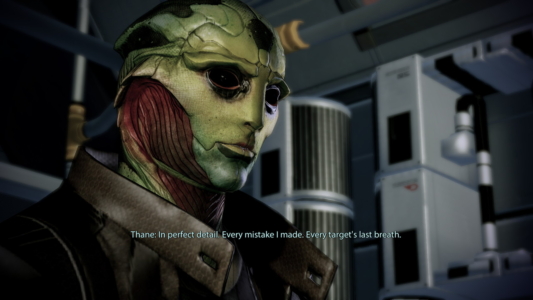

 Posts
Posts
First rate review for a first rate game. Bravo and thanks.
Now expecting you to share soon your experience with Mass Effect 3 — including the ending everyone but me seems to have hated as much as Game of Thrones’ one. 😉
Very nice work indeed.
April 23, 2021 @ 8:40 pm
Great work, as always!
Looking back, I’m really blasé about the whole Mass Effect series, even though it would seem like something I’d really carry the banner for. It wasn’t the ending of 3 – I’d probably stopped caring before then – but I’m not sure I can pin down exactly why. Reading this review though, maybe it was the shift away from RPG and more toward action that did it.
April 25, 2021 @ 7:16 pm
Thanks both.
Not sure if I’ll belatedly become an ME series superfan or not, but am certainly enjoying the chance to catch up with them while I can!
And yes, the third one will indeed follow. Thought I might be able to get the trilogy done before the Legendary Edition release but that seems very unlikely now.
April 26, 2021 @ 5:44 pm